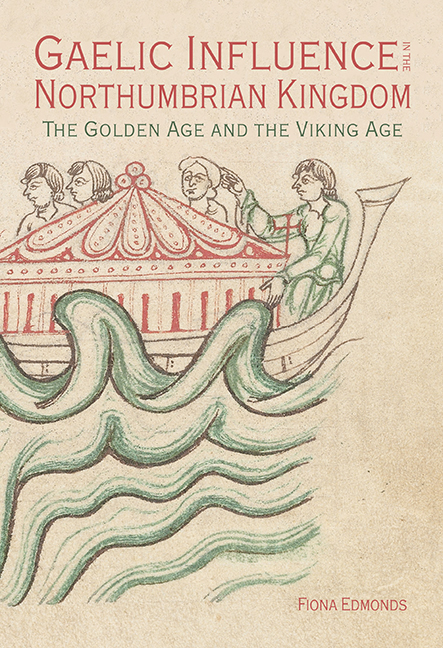Book contents
- Frontmatter
- Contents
- List of Illustrations
- Acknowledgements
- List of Abbreviations
- Preface: An Eventful Voyage
- 1 Concepts and Historiography of the Northumbrian and Gaelic Worlds: Medieval to Modern
- 2 Exiles and Emperors: Gaelic-Northumbrian Political Relations in the Golden Age
- 3 Fragmentation and Opportunity: From the Eighth Century to the Viking Age
- 4 Pathways through the Past: Routes between the Gaelic World and the Northumbrian Kingdom
- 5 A Golden Age of Ecclesiastical Contacts
- 6 Saints and Seaways in the Viking Age
- 7 Medieval Multilingualism: Gaelic Linguistic Influence in the Northumbrian Kingdom
- 8 Movement and Material Culture in the Northumbrian and Gaelic Worlds
- Conclusion: Individuals and Influences
- Bibliography
- Index
- STUDIES IN CELTIC HISTORY
4 - Pathways through the Past: Routes between the Gaelic World and the Northumbrian Kingdom
Published online by Cambridge University Press: 28 February 2020
- Frontmatter
- Contents
- List of Illustrations
- Acknowledgements
- List of Abbreviations
- Preface: An Eventful Voyage
- 1 Concepts and Historiography of the Northumbrian and Gaelic Worlds: Medieval to Modern
- 2 Exiles and Emperors: Gaelic-Northumbrian Political Relations in the Golden Age
- 3 Fragmentation and Opportunity: From the Eighth Century to the Viking Age
- 4 Pathways through the Past: Routes between the Gaelic World and the Northumbrian Kingdom
- 5 A Golden Age of Ecclesiastical Contacts
- 6 Saints and Seaways in the Viking Age
- 7 Medieval Multilingualism: Gaelic Linguistic Influence in the Northumbrian Kingdom
- 8 Movement and Material Culture in the Northumbrian and Gaelic Worlds
- Conclusion: Individuals and Influences
- Bibliography
- Index
- STUDIES IN CELTIC HISTORY
Summary
There is a modern vogue for treading in the tracks of ancient travellers and recreating the voyages of early seafarers. Cultural interaction takes place against an enduring geographical background: the strength of the tides, climatic shifts, and the paths of least resistance. So far I have elucidated the reasons why royalty, warbands, exiles and settlers moved between Gaeldom and the Northumbrian kingdom; these travellers would have encountered the intractable bogs of the Pennines and the unpredictable state of the Irish Sea. To support my case that there were varied channels of Gaelic influence on the Northumbrian kingdom, I need to show that travel was feasible in the early medieval period.
Early medieval route-ways can be faintly perceived through the fog of the fragmentary evidence. Chroniclers rarely commented on the practicalities of transport, and few administrative documents are available until the late-medieval period. Small finds and place-names help to pinpoint hubs in the transport network, while pollen diagrams from certain sites offer some insight into the effects of landscape and climate change. My strategy is to investigate Roman and late-medieval infrastructure, and to compare this information with a range of early medieval material. I then investigate each major route-way in turn, showing that a variety of links between the Northumbrian and the Gaelic world were usable, and used. In the future, it would be worthwhile to consider the choices made between these various route-ways by using GIS (Geographical Information Systems) mapping to understand visibility, the effort involved in traversing the landscape, and proximity to transport nodes.
The longue durée perspective is well established in studies of pre-modern communication. Fernand Braudel's seminal work on the Mediterranean revealed how landscape and seascape gave rise to ingrained patterns of behaviour and modes of thinking. Peregrine Horden and Nicholas Purcell have explored the Mediterranean over an extended period, and proposed two interpretations of communication: the ‘interactionist’ model, in which the sea provides a means of linking disparate peoples, and the ‘ecologising’ model, which emphasises their common environmental circumstances. The Irish Sea has long been compared with the Mediterranean in terms of cultural contact, and the concept of the ‘Irish Sea province’ has appeared in scholarship ranging from the Neolithic to the medieval period.
- Type
- Chapter
- Information
- Gaelic Influence in the Northumbrian KingdomThe Golden Age and the Viking Age, pp. 72 - 98Publisher: Boydell & BrewerPrint publication year: 2020



